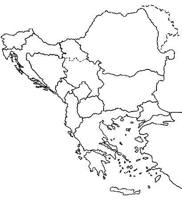
|
The Society of Folk Dance Historians (SFDH)
Isn't it Too Bad that the
[
Home |
About |
Encyclopedia | CLICK AN IMAGE TO ENLARGE |

|
 The reason that the old dances are dying out is because the life of which they once were an organic part is no longer viable. By that I mean the reasons they give such interesting steps to the men, and such dull steps to the women, are not because that was beautiful and old and a 'cute' type of contrast, but because it was built into their system of life. It wasn't that the dances were in a vacuum, unattached to any other part of life; it was throughout your LIFE, you as a woman had no business with the men, excepting sexual business. For example, the only way that boy could meet girl was to show up on those rare occasions when one danced. Now, there were other ways, but in general, society sanctioned your meeting members of the opposite sex at a fair or at a Sunday afternoon dance, and your roles there were very much prescribed. To be a teenager in the Balkans was really a very restricted existence. The dance functioned as a part of that. Never think that the dance was something in which the rest of life disappeared. Peasants didn't go to a dance and suddenly become those marvelous, red-bandannaed, earringed, Balkan Romani types that you see in all the 1930s movies, then returning to the soil.
The reason that the old dances are dying out is because the life of which they once were an organic part is no longer viable. By that I mean the reasons they give such interesting steps to the men, and such dull steps to the women, are not because that was beautiful and old and a 'cute' type of contrast, but because it was built into their system of life. It wasn't that the dances were in a vacuum, unattached to any other part of life; it was throughout your LIFE, you as a woman had no business with the men, excepting sexual business. For example, the only way that boy could meet girl was to show up on those rare occasions when one danced. Now, there were other ways, but in general, society sanctioned your meeting members of the opposite sex at a fair or at a Sunday afternoon dance, and your roles there were very much prescribed. To be a teenager in the Balkans was really a very restricted existence. The dance functioned as a part of that. Never think that the dance was something in which the rest of life disappeared. Peasants didn't go to a dance and suddenly become those marvelous, red-bandannaed, earringed, Balkan Romani types that you see in all the 1930s movies, then returning to the soil.
If I were to say, "Yes, it's too bad the old dances are dying out," I would also have to say, "Yes, it's too bad that they had to improve the plumbing; it's too bad that they now have radios and conveniences; it's just a crime that their milk is pasteurized now." I would have to say, "It's just too bad that we can't go back to the days of the lily-whiters, when the boys danced in one room and the girls danced in another. Yes, it is too bad that boys and girls are able now to choose whom they marry, instead of the parents bargaining for future mates for their kids before those kids could walk." I would be REQUIRED to say that if I said, "Yes, it's too bad that the old dances are dying out." The truth of the matter is that people's dances are every bit as much an organic part of the way they live, and have chosen to live, as any other aspect of their lives.
 "It's too bad that the old costumes are dying out in Yugoslavia, isn't it?" "Yes," I've got to say, "it's too bad that when they go to work in the factories nowadays, they can't wear their gorgeously embroidered chemises; it's just too bad that in order to keep up with their needs for modern comfort they don't have the hours and hours of poverty-stricken boredom in which to produce these intricately embroidered sleeves."
"It's too bad that the old costumes are dying out in Yugoslavia, isn't it?" "Yes," I've got to say, "it's too bad that when they go to work in the factories nowadays, they can't wear their gorgeously embroidered chemises; it's just too bad that in order to keep up with their needs for modern comfort they don't have the hours and hours of poverty-stricken boredom in which to produce these intricately embroidered sleeves."
The romantic idea that generations of happy peasants have produced these costumes for us to buy and wear, have produced these intriguing dances for us to do, is totally unrelated to the fact that they are human beings, and that they have needs and desires the same as we do. That's not to say that in Yugoslavia it's not possible now to enjoy these things; it is, but not on the basis of "Oh, it's too bad they're dying out," but to enjoy them on the basis of their intrinsic beauty. They are things of beauty, and as such, they are now being preserved rather like other things are being preserved in museums. You ARE able to enjoy Turopoljski Drmeš. It's dead now; no one does it in Turopolje, except the little group that drags it out every couple of months and performs it at a festival. We can share in that dance as a memento of times past and enjoy it for its beauty, but to regret that it's dead is to be a bit unaware of the fact that it's 1974.
DOCUMENT
- Dick Crum, an article.
This page © 2018 by Ron Houston.
Please do not copy any part of this page without including this copyright notice.
Please do not copy small portions out of context.
Please do not copy large portions without permission from Ron Houston.